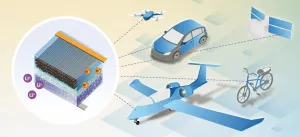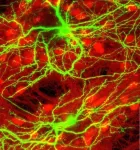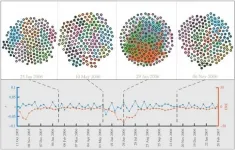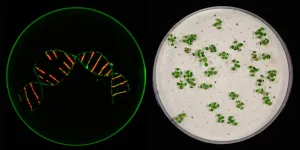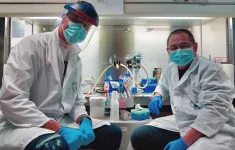(Press-News.org) Researchers from Chalmers University of Technology have produced a structural battery that performs ten times better than all previous versions. It contains carbon fibre that serves simultaneously as an electrode, conductor, and load-bearing material. Their latest research breakthrough paves the way for essentially 'massless' energy storage in vehicles and other technology.
The batteries in today's electric cars constitute a large part of the vehicles' weight, without fulfilling any load-bearing function. A structural battery, on the other hand, is one that works as both a power source and as part of the structure - for example, in a car body. This is termed 'massless' energy storage, because in essence the battery's weight vanishes when it becomes part of the load-bearing structure. Calculations show that this type of multifunctional battery could greatly reduce the weight of an electric vehicle.
The development of structural batteries at Chalmers University of Technology has proceeded through many years of research, including previous discoveries involving certain types of carbon fibre. In addition to being stiff and strong, they also have a good ability to store electrical energy chemically. This work was named by Physics World as one of 2018's ten biggest scientific breakthroughs.
The first attempt to make a structural battery was made as early as 2007, but it has so far proven difficult to manufacture batteries with both good electrical and mechanical properties. But now the development has taken a real step forward, with researchers from Chalmers, in collaboration with KTH Royal Institute of Technology in Stockholm, presenting a structural battery with properties that far exceed anything yet seen, in terms of electrical energy storage, stiffness and strength. Its multifunctional performance is ten times higher than previous structural battery prototypes.
The battery has an energy density of 24 Wh/kg, meaning approximately 20 percent capacity compared to comparable lithium-ion batteries currently available. But since the weight of the vehicles can be greatly reduced, less energy will be required to drive an electric car, for example, and lower energy density also results in increased safety. And with a stiffness of 25 GPa, the structural battery can really compete with many other commonly used construction materials.
"Previous attempts to make structural batteries have resulted in cells with either good mechanical properties, or good electrical properties. But here, using carbon fibre, we have succeeded in designing a structural battery with both competitive energy storage capacity and rigidity," explains Leif Asp, Professor at Chalmers and leader of the project.
Super light electric bikes and consumer electronics could soon be a reality
The new battery has a negative electrode made of carbon fibre, and a positive electrode made of a lithium iron phosphate-coated aluminium foil. They are separated by a fibreglass fabric, in an electrolyte matrix. Despite their success in creating a structural battery ten times better than all previous ones, the researchers did not choose the materials to try and break records - rather, they wanted to investigate and understand the effects of material architecture and separator thickness.
Now, a new project, financed by the Swedish National Space Agency, is underway, where the performance of the structural battery will be increased yet further. The aluminium foil will be replaced with carbon fibre as a load-bearing material in the positive electrode, providing both increased stiffness and energy density. The fibreglass separator will be replaced with an ultra-thin variant, which will give a much greater effect - as well as faster charging cycles. The new project is expected to be completed within two years.
Leif Asp, who is leading this project too, estimates that such a battery could reach an energy density of 75 Wh/kg and a stiffness of 75 GPa. This would make the battery about as strong as aluminium, but with a comparatively much lower weight.
"The next generation structural battery has fantastic potential. If you look at consumer technology, it could be quite possible within a few years to manufacture smartphones, laptops or electric bicycles that weigh half as much as today and are much more compact", says Leif Asp.
And in the longer term, it is absolutely conceivable that electric cars, electric planes and satellites will be designed with and powered by structural batteries.
"We are really only limited by our imaginations here. We have received a lot of attention from many different types of companies in connection with the publication of our scientific articles in the field. There is understandably a great amount of interest in these lightweight, multifunctional materials," says Leif Asp.
INFORMATION:
Read the article in the scientific journal Advanced Energy & Sustainability Research:
A Structural Battery and its Multifunctional Performance
Watch a Youtube video here: Structural battery with record performance
More about: The research on structural batteries
The structural battery uses carbon fibre as a negative electrode, and a lithium iron phosphate-coated aluminium foil as the positive electrode. The carbon fibre acts as a host for the lithium and thus stores the energy. Since the carbon fibre also conducts electrons, the need for copper and silver conductors is also avoided - reducing the weight even further. Both the carbon fibre and the aluminium foil contribute to the mechanical properties of the structural battery. The two electrode materials are kept separated by a fibreglass fabric in a structural electrolyte matrix. The task of the electrolyte is to transport the lithium ions between the two electrodes of the battery, but also to transfer mechanical loads between carbon fibres and other parts.
The project is run in collaboration between Chalmers University of Technology and KTH Royal Institute of Technology, Sweden's two largest technical universities. The battery electrolyte has been developed at KTH. The project involves researchers from five different disciplines: material mechanics, materials engineering, lightweight structures, applied electrochemistry and fibre and polymer technology. Funding has come from the European Commission's research program Clean Sky II, as well as the US Airforce.
Announcing a new article publication for BIO Integration journal. In this review article the authors Oliver K. Semisch-Dieter, Andy H. Choi and Martin P. Stewart from the University of Technology Sydney, Ultimo, NSW, Australia discuss the use of biomaterials in dental implants.
Biomaterials have become essential for modern implants. A suitable implant biomaterial integrates into the body to perform a key function, whilst minimizing negative immune response. Focusing on dentistry, the use of dental implants for tooth replacement requires a balance between bodily response, mechanical structure and performance, and aesthetics. ...
A team of researchers from Tübingen and Israel uncovers how brain structures can maintain function and stable dynamics even in unusual conditions. Their results might lay the foundations for better understanding and treating conditions like epilepsy and autism.
The neurons in our brains are connected with each other, forming small functional units called neural circuits. A neuron that is connected to another one via a synapsis can transmit information to the second neuron by sending a signal. This, in turn, might prompt the second neuron to transmit a signal to ...
Tsukuba, Japan - An earthquake is generally viewed to be caused by a rupture along a fault that is transmitted outward from its point of origin in a uniform, predictable pattern. Of course, given the complexity of the environments where these ruptures typically occur, the reality is often much more complicated.
In a new study published in Scientific Reports, a research team led by the University of Tsukuba developed a new method to model the details of complex earthquake rupture processes affecting systems of multiple faults. They then applied this method to the magnitude ...
An international team of interdisciplinary researchers has identified mathematical metrics to characterize the fragility of financial markets. Their paper "Network geometry and market instability" sheds light on the higher-order architecture of financial systems and allows analysts to identify systemic risks like market bubbles or crashes.
With the recent rush of small investors into so-called meme stocks and reemerging interest in cryptocurrencies talk of market instability, rising volatility, and bursting bubbles is surging. However, "traditional economic theories cannot foresee events like the US subprime mortgage collapse of 2007" according ...
Point
Epithelial cell rests of Malassez derived from the periodontal ligament were transformed into progenitor stem-like cells by stimulation with epigenetic agents.
Subsequently, the progenitor stem-like cells were directly differentiated into endothelial, mesenchymal stem, and osteogenic cells that constitute the periodontal ligament.
Background
Stem cells derived from the dental pulp or periodontal ligament have been used for regenerative dentistry. Although it is relatively easy to collect the dental pulp stem cells, it is difficult to obtain adequate numbers of good quality cells; a ...
Using an improved version of the gene editing tool CRISPR/Cas9, researchers knocked out up to twelve genes in plants in a single blow. Until now, this had only been possible for single or small groups of genes. The approach was developed by researchers at Martin Luther University Halle-Wittenberg (MLU) and the Leibniz Institute of Plant Biochemistry (IPB). The method makes it easier to investigate the interaction of various genes. The study appeared in The Plant Journal.
The inheritance of traits in plants is rarely as simple and straightforward as Gregor Mendel described. The monk, whose experiments in the 19th century on trait inheritance in peas laid the foundation of genetics, in fact got lucky. "In the traits that ...
Patricia Bernal, a Ramón y Cajal researcher at the Department of Microbiology of the University of Seville's Faculty of Biology, is working with the bacterium Pseudomonas putida, a biological control agent found in the soil and in plant roots and which, as such, has the ability to protect plants from pathogen attacks (organisms that cause diseases) also known as phytopathogens. Specifically, the US researcher is studying a molecular weapon that bacteria use (Type VI Secretion System or T6SS) to eliminate their competitors.
The T6SS could be compared to a harpoon with a poisonous tip that bacteria throw at their enemies to annihilate them. In a recent paper, which has just been published in the scientific journal PNAS and for ...
Igor Stagljar made his career building molecular tools to combat cancer. But when the pandemic hit last March, he aimed his expertise at a new adversary, SARS-CoV-2.
Stagljar is a professor of biochemistry and molecular genetics in the Donnelly Centre for Cellular and Biomolecular Research at U of T's Temerty Faculty of Medicine. Last spring, with support from U of T's Toronto COVID-19 Action Fund, his team began developing a new method for measuring immunity to coronavirus in those who recovered from COVID-19.
They are now ready to reveal their creation -- a pinprick test that accurately measures ...
"You have to win the battle against depression", "what counts is not surrendering" and "this is not a short road" are examples of conceptual metaphors typically used to describe experiences and issues associated with disorders like depression. Such expressions allude to abstract concepts but do so using familiar terms that enable better understanding of the experience. This kind of metaphor is often used unconsciously, going unnoticed by both speaker and listener. However, the study of metaphors can help access and understand the thinking, beliefs and feelings of individuals with mental disorders.
The conceptual metaphors of depression found in 23 blogs written by people with major depressive disorders were analysed by a multidisciplinary UOC team composed of Marta Coll-Florit and Salvador ...
The results argue for a comprehensive approach to disease prevention. The scientists have now published their findings in the journal Nature Medicine.
Many elderly people suffer simultaneously from several, frequently very different diseases, a condition also known as multimorbidity. Their quality of life is severely restricted, and they receive medication from different doctors, a process which is difficult and often insufficiently coordinated. Observations indicate that certain diseases commonly occur together, but the causes of this are largely ...
